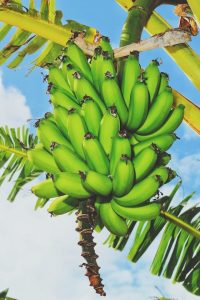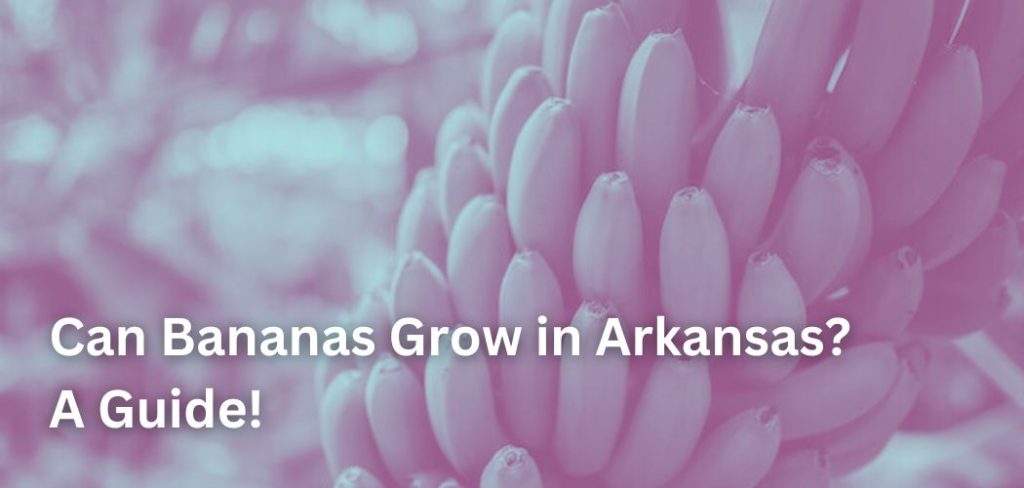Bananas are a popular fruit that is enjoyed all over the world. However, due to their tropical origins, many people wonder if bananas can grow in Arkansas.
The answer is yes, bananas can grow in Arkansas with the right conditions and care.
Understanding Banana Growth is crucial to successfully growing bananas in Arkansas. Bananas are perennial plants that grow in warm and humid conditions.
They require plenty of sunlight, water, and nutrients to thrive.
The banana plant grows from a rhizome and produces a pseudostem that can reach up to 30 feet in height.
The plant also produces large leaves that can be up to 9 feet long and 2 feet wide. The banana fruit grows in clusters and can take up to 9 months to mature.
Key Takeaways
- Bananas can grow in Arkansas with the right conditions and care.
- Understanding Banana Growth is crucial to successfully growing bananas in Arkansas.
- Bananas require plenty of sunlight, water, and nutrients to thrive.
Understanding Banana Growth
Bananas are tropical plants that require specific conditions to grow and thrive. Understanding the growth requirements of banana plants is essential for anyone interested in growing them in Arkansas.
Climate
Banana plants require a warm and humid climate to grow. They cannot tolerate frost or freezing temperatures and require temperatures between 75-85°F for optimal growth.
In Arkansas, the climate is usually too cold for banana plants to survive, with the average temperature ranging from 40-50°F.
Sunlight
Banana plants require full sun to grow and produce fruit. They require at least 6-8 hours of direct sunlight per day.
In Arkansas, banana plants need to be planted in a location that receives full sun all day long to thrive.
Watering
Banana plants require consistent watering to thrive. They require deep watering once or twice a week, depending on the weather.
The soil should be kept moist, but not waterlogged. In Arkansas, banana plants may require more frequent watering due to the dry climate.
Leaves
Banana plants have large, broad leaves that can grow up to 9 feet long.
The leaves are the main site of photosynthesis and are essential for the plant’s growth and development.
The leaves can also provide shade and protection for the fruit.
Flowers
Banana plants produce flowers that develop into fruit. The flowers are large and showy, with a bright yellow color.
The flowers are produced in clusters, with each cluster containing up to 20 individual flowers.
Pseudostem
The pseudostem is the main stem of the banana plant. It is made up of tightly packed leaf sheaths that wrap around each other.
The pseudostem can grow up to 20 feet tall and provides support for the leaves and fruit.
Overall, banana plants require a warm and humid climate, full sun, consistent watering, and a healthy pseudostem to grow and produce fruit.
While it may be challenging to grow bananas in Arkansas, it is possible with the right conditions and care.
Bananas in Arkansas
Climate Compatibility
Bananas are generally considered to be tropical plants, and many people assume that they cannot be grown in Arkansas.
However, the truth is that bananas can actually thrive in Arkansas, as long as they are given the right growing conditions. One of the most important factors to consider when growing bananas in Arkansas is the climate.
Bananas require a warm and humid climate to grow, and Arkansas is well-suited to provide these conditions.
The state has a humid subtropical climate, with long, hot summers and mild winters.
The average annual rainfall in Arkansas is around 50 inches, which is more than enough to keep banana plants healthy and hydrated.
Hardiness Zones
Another important factor to consider when growing bananas in Arkansas is the hardiness zones.
Banana plants are considered to be cold hardy, which means that they can tolerate some cold temperatures. However, they are not able to survive in extremely cold conditions.
Arkansas is divided into several different hardiness zones, which range from zone 6a in the north to zone 8b in the south.

Banana plants can be grown in zones 8a and 8b, which are located in the southern part of the state.
In these zones, the average minimum temperature is around 10 to 15 degrees Fahrenheit, which is warm enough to support the growth of banana plants.
In conclusion, bananas can be successfully grown in Arkansas as long as the right growing conditions are provided.
The state’s warm and humid climate, combined with its suitable hardiness zones, make it an excellent location for growing banana plants.
Growing Conditions
Sunlight Requirements
Banana plants require full sun to grow. They need at least 6 to 8 hours of direct sunlight daily. In Arkansas, banana plants should be placed in a location that receives full sun. If the plants are not getting enough sunlight, they will not produce fruit.
Watering Requirements
Banana plants require consistent watering. The soil should be kept moist, but not waterlogged. Overwatering can cause root rot, while underwatering can cause the leaves to turn brown and dry up. In Arkansas, banana plants should be watered regularly, especially during the hot summer months.
Soil Preferences
Banana plants prefer well-drained soil that is rich in organic matter. The soil should be loose and crumbly, allowing for good drainage. Adding compost, manure, or peat moss to the soil can help improve its quality. In Arkansas, banana plants should be planted in soil that has been amended with organic matter.
Overall, banana plants can grow in Arkansas if they are provided with the proper growing conditions. They require full sun, consistent watering, and well-drained soil that is rich in organic matter. By following these guidelines, gardeners in Arkansas can successfully grow banana plants and enjoy their delicious fruit.
Planting and Care
Planting Process
Bananas are tropical plants that require a lot of sun and warm temperatures to thrive. According to Foliargarden.com, it is not possible to grow bananas in Arkansas due to the state’s climate. However, some gardeners have had success growing bananas in Arkansas by creating microclimates in their gardens. To plant bananas in Arkansas, gardeners should select a site that receives a lot of sun and has well-draining soil.
The planting process for bananas is straightforward. Gardeners should dig a hole that is two to three times the width of the banana plant’s root ball and the same depth as the root ball. The banana plant should be placed in the hole, and the soil should be backfilled around the plant. The soil should be gently tamped down to remove any air pockets.
Fertilizing and Care
Bananas require regular fertilization to grow and produce fruit. Gardeners should fertilize banana plants every two to three months during the growing season with a balanced fertilizer. According to the University of Arkansas System Division of Agriculture, banana plants should be fertilized with 1 pound of 8-10-8 fertilizer per plant every two months during the growing season.
In addition to fertilization, banana plants require regular watering. Gardeners should water banana plants deeply once a week during the growing season. Banana plants also benefit from mulching, which helps to retain moisture in the soil and suppress weeds.
Pest and Disease Management
Banana plants are susceptible to several pests and diseases, including aphids, spider mites, and Panama disease. Gardeners should inspect banana plants regularly for signs of pests and diseases. If pests or diseases are detected, gardeners should take immediate action to prevent the spread of the problem.
To prevent pests and diseases, banana plants should be pruned regularly to remove dead or diseased leaves. Gardeners should also avoid overwatering banana plants, as this can lead to fungal diseases. If pests or diseases are detected, gardeners can use insecticidal soap or neem oil to control pests and copper fungicides to control fungal diseases.
Overall, growing bananas in Arkansas can be challenging due to the state’s climate. However, with proper care and attention, it is possible to grow bananas in microclimates in the garden. Gardeners should select a site that receives a lot of sun and has well-draining soil, fertilize and water regularly, and inspect banana plants regularly for signs of pests and diseases.
Harvesting and Usage
Harvesting Process
Bananas are harvested when they are still green and unripe. The fruit is cut from the plant with a sharp knife and then transported to a ripening facility. Once at the facility, the bananas are stored at a temperature of 56 to 60 degrees Fahrenheit (13 to 16 degrees Celsius) and exposed to ethylene gas, which triggers the ripening process.
The ripening process takes about 4 to 7 days, depending on the temperature and humidity levels. During this time, the bananas turn yellow and become sweeter as the starches are converted to sugars.
Usage of Bananas
Bananas are a versatile fruit that can be used in a variety of ways. They can be eaten raw as a snack, added to smoothies, or used in baking. Bananas are also a great source of dietary fiber, which can help regulate digestion and promote overall gut health.

In addition to being a tasty and nutritious snack, bananas can also be used to ripen other fruits. This is because bananas release ethylene gas, which triggers the ripening process in other fruits. Simply place a banana in a paper bag with other fruits, such as avocados or tomatoes, and the ethylene gas will help them ripen faster.
Overall, bananas are a delicious and healthy fruit that can be enjoyed in many different ways. Whether eaten raw or used in cooking, bananas are a great addition to any diet.
Alternative Banana Growing Methods
If you live in Arkansas and want to grow bananas, you may be wondering if there are alternative methods to growing this tropical fruit. Fortunately, there are a few methods that can help you grow bananas even if you don’t have the ideal climate or outdoor space. Here are some alternative banana growing methods to consider:
Indoor Banana Plants
One way to grow bananas in Arkansas is to grow them indoors. Indoor banana plants can be grown in containers and placed near a sunny window. Dwarf Cavendish is a popular banana variety that can be grown indoors. These plants require a warm and humid environment, so it’s important to keep the soil moist and use a humidifier if necessary.
Indoor banana plants can provide a tropical look to your home, and they can also produce fruit if cared for properly. However, it’s important to note that indoor banana plants may not produce as much fruit as outdoor plants, and they may require additional care and attention.
Potted Banana Plants
Another alternative method for growing bananas in Arkansas is to grow them in pots. Potted banana plants can be grown outdoors during the warm months and brought indoors during the colder months. This method allows you to control the growing environment and protect the plants from harsh weather conditions.
When growing potted banana plants, it’s important to choose a variety that is suitable for container growing, such as Dwarf Cavendish. These plants require a large pot with good drainage and regular watering. It’s also important to fertilize the plants regularly to promote healthy growth.

In conclusion, if you want to grow bananas in Arkansas, there are alternative methods to consider. Indoor banana plants and potted banana plants can provide a tropical look to your home and produce fruit if cared for properly. By choosing the right variety and providing the appropriate growing conditions, you can enjoy fresh bananas even if you don’t have the ideal climate or outdoor space.
Other Fruits in Arkansas
Arkansas is a great place to grow fruits and vegetables. In addition to bananas, there are several other fruits that can thrive in the state’s climate. Here are some other fruits that you can consider growing in Arkansas:
Growing Tomatoes
Tomatoes are one of the most popular fruits to grow in Arkansas. They are easy to grow and can be grown in containers or in the ground. Tomatoes require full sun and well-drained soil. They can be started from seeds indoors or purchased as seedlings from a nursery. Some popular tomato varieties to grow in Arkansas include:
- Celebrity
- Better Boy
- Early Girl
- Roma
Tomatoes are high in vitamins A and C and are a great addition to salads, sandwiches, and pasta dishes.
Growing Peppers
Peppers are another popular fruit to grow in Arkansas. They come in a variety of colors and flavors, from sweet to spicy. Peppers require full sun and well-drained soil. They can be started from seeds indoors or purchased as seedlings from a nursery. Some popular pepper varieties to grow in Arkansas include:
- Bell peppers
- Jalapenos
- Habaneros
- Banana peppers
Peppers are high in vitamin C and can be used in a variety of dishes, from stir-fries to salsas.
Growing Apples
Apple trees can also be grown in Arkansas. They require full sun and well-drained soil. Some popular apple varieties to grow in Arkansas include:
- Golden Delicious
- Red Delicious
- Granny Smith
Apples are high in fiber and vitamin C and can be eaten fresh or used in a variety of baked goods, from pies to muffins.
In addition to these fruits, there are many other fruits and vegetables that can be grown in Arkansas, including berries, cucumbers, and herbs. With the right growing conditions and care, you can enjoy a bountiful harvest of fresh fruits and vegetables from your own backyard.
